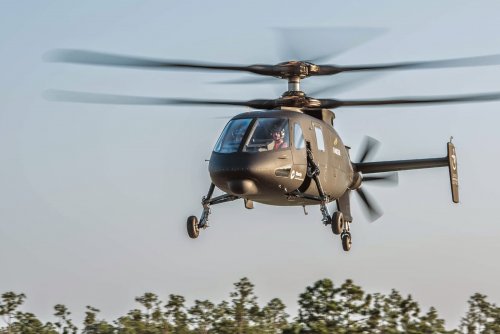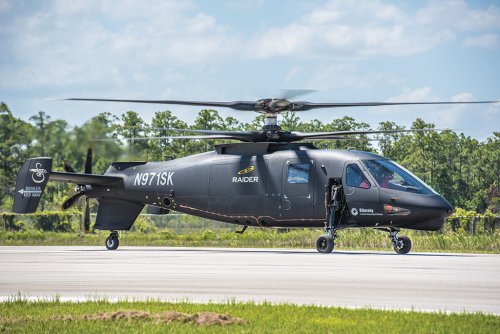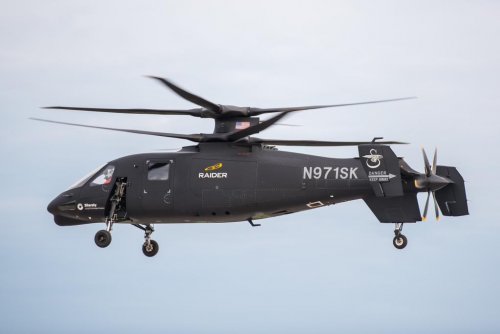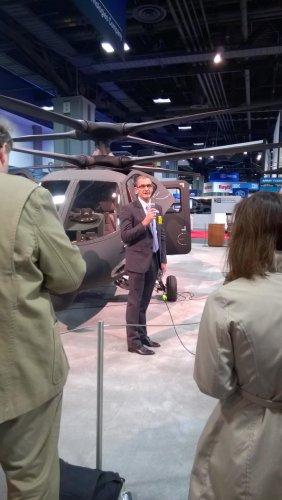You are using an out of date browser. It may not display this or other websites correctly.
You should upgrade or use an alternative browser.
You should upgrade or use an alternative browser.
Sikorsky S-97 Raider
- Thread starter Triton
- Start date
"Sikorsky Conducts First Flight Of S-97 Helo"
by Graham Warwick
May 22, 2015
Source:
http://aviationweek.com/defense/sikorsky-conducts-first-flight-s-97-helo
by Graham Warwick
May 22, 2015
Source:
http://aviationweek.com/defense/sikorsky-conducts-first-flight-s-97-helo
Sikorsky flew its S-97 Raider rigid coaxial-rotor, high-speed helicopter for the first time May 22, completing a hover and low-speed flight at the company’s development flight center in West Palm Beach, Florida.
The aircraft is the first of two prototypes of the Raider light tactical helicopter being built under a $200 million industry effort funded by Sikorsky and its supplier partners. This follows the $50 million company-funded X2 Technology Demonstrator, which flew 23 times from 2008-11.
The Raider flew for 1 hr. instead of the 30 min. planned, says Mark Miller, vice president of research and engineering. It completed three takeoffs and landings: forward, rearward and sideward. The aircraft was flown by Raider chief pilot Bill Fell, with X2 test pilot Kevin Bredenbeck as co-pilot.
Rolled out Oct. 2, the first Raider had completed 36 hr. of shakedown ground runs since February. This culminated in an untethered ground run on May 20, clearing the aircraft for flight.
All 97 points on the “aggressive” first-flight test card were completed, including piloted frequency sweeps in all axes, something normally considered too risky for a first flight, Fell says.
The X2 demonstrator last flew in July 2011, having exceeded 250 kt., and Bredenbeck says the flight of the production-representative Raider “picked up … like the X2 program never ended.”
For this initial flight, the Raider was flown with its triplex fly-by-wire flight control system in backup degraded mode so as to focus on basic airworthiness in the low-speed regime, Fell says.
Over about 100 hr. of flight testing, aircraft 1 will expand the Raider’s flight envelope with the goal of achieving the program’s key performance parameters (KPP) by mid-2016, Miller says. These include demonstrating hover out of ground effect at mission weight at 6,000 ft. altitude on a 95F day (6k/95); 220 kt. cruise speed with external weapons; and 3G maneuverability at speed.
Flight testing will be conducted in three phases involving two blocks of flight-control software, Program Manager Mark Hammond says. For initial flights with Block 1 software, the Raider will fly in traditional helicopter mode without the propulsor engaged.
The Raider will be flown to 140-150 kt. in pure helicopter mode, Miller says. Toward the end of Phase 1, software will be upgraded to Block 2, bringing in the propulsor and articulating tail to increase speed and enable the full flight envelope.
Phases 1 and 2 will demo the hover KPP carrying the equivalent of six troops and two crewmembers as well as an endurance objective. Phase 2 will focus on demonstrating – and likely exceeding – the speed objective. “Raider is a balanced design optimized for more than 220 kt. fully weaponized, but the inherent speed of the configuration is more than 250 kt.,” Miller says. “That’s 100 kt. faster than anything else.”
Phase 3 will demo the maneuverability potential of the rigid coaxial rotor and propulsor. In addition to enabling level-attitude acceleration and deceleration and pushing the helicopter to higher forward speeds, the variable-pitch propeller can be used to produce reverse thrust, enabling the Raider to “hang on the prop” to point sensors and weapons toward the ground.
The second Raider is being assembled and is expected to fly late this year or in early 2016. Where aircraft 1 is heavily instrumented for envelope expansion and will remain at West Palm Beach, aircraft 2 is intended for customer demonstrations and, after an initial 50 hr. of flight testing, will be released to conduct demo tours to other locations. Aircraft 1 will be a backup.
The formal program will end once the KPPs have been accomplished, but the customer demonstrations will be open ended, Miller says. Sikorsky is in discussions with industry partners and potential customers about fitting specific sensors and weapons to aircraft 2 for demos in operational scenarios.
When Sikorsky launched the Raider program, it was aiming at the U.S. Army’s Armed Aerial Scout (AAS) requirement. This has since been shelved, with Boeing AH-64 Apache attack helicopters being used as armed scouts to replace the Army’s Bell OH-58D Kiowa Warriors, which are being retired.
Current Army plans call for a new Future Vertical Lift (FVL) Light armed scout sometime after 2030. But Sikorsky’s goal in demonstrating the operational effectiveness of the Raider using production-representative prototypes is to persuade the Army to revisit AAS or pull FVL Light forward.
While the X2 had a gross weight of 6,000 lb., the Raider weighs around 11,000 lb. and, Miller says, is also serving as a risk reducer for the 30,000-lb.-class SB-1 Defiant being built by Sikorsky and Boeing for the Army’s Joint Multi Role technology demonstation, a precursor to the FVL Medium program.
"S-97 Raider makes debut test flight"
By: Stephen Trimble
Washington DC
Source:
http://www.flightglobal.com/news/articles/s-97-raider-makes-debut-test-flight-412703/
By: Stephen Trimble
Washington DC
Source:
http://www.flightglobal.com/news/articles/s-97-raider-makes-debut-test-flight-412703/
Sikorsky has completed a first flight of the self-funded S-97 Raider at the company's flight test facility in West Palm Beach, Florida, to open a year-long test and demonstration phase for the high-speed, compound helicopter proposed for light attack, scout and special utility missions.
The S-97’s coaxial-compound, rigid-rotor configuration will eventually be tested at speeds up to 220kt – or about 50kt faster than the speed limit of most conventional helicopters – but the maiden flight on 22 May focused on exploring the low-speed envelope in a degraded mode of the fly-by-wire system.
Sikorsky chief pilot Bill Fell and co-pilot Kevin Bredenbeck completed three take-offs and landings during the hour-long sortie and evaluated the aircraft’s handling in all four cardinal directions at speeds up to 10kt.
“It was quite the aggressive first flight for a helicopter,” says Bredenbeck, who piloted the X2, the S-97’s proof-of-concept demonstrator.
asset image
Sikorsky
Sikorsky launched the S-97 project in 2010 after completing a series of record-breaking demonstration flights of the X2.
A 48-month technology demonstration programme was extended by more than four months to complete several new technologies. The S-97 is configured as a testbed for a variety of development projects within Sikorsky, including components made through additive manufacturing, a low-fastener-count approach to structural assembly, and new composite materials.
“The S-97 is a testbed for a lot new technology and some of those took a little bit longer,” says Sikorsky vice-president of research and engineering Mark Miller.
The S-97 flies faster than most helicopters because it replaces a tail-rotor with a pusher propeller, which was left deactivated for the first flight test. The counter-torque function of the tail rotor is replaced with a counter-rotating, coaxial rotor system that provides vertical thrust for takeoff and landing.
The rigid blades of the coaxial rotor system provide another benefit over a conventional Sikorsky helicopter.
“You have a phenomenal amount of control power with this very rigid rotor,” Fell says. “There is no lag. The aircraft responds immediately to your control input.”
The 5t-class S-97 is part of a wave of industry investment in high-speed technology.
The Bell Boeing V-22 Osprey now flies faster than 260kt and land vertically using a tiltrotor configuration. Bell Helicopter is currently developing the V-280 Valor tiltrotor demonstrator with Lockheed Martin.
The V-280 is competing against a Sikorsky-Boeing compound helicopter design based on same X2 technology as the S-97 with the 13.5t-class SB-1 Defiant.
The V-280 and SB-1 will perform a series of flight tests to validate the high-speed technology under the army’s joint multi-role technology demonstrator (JMR-TD) programme.
Both aircraft designs are expected to compete for a follow-on acquisition programme called Future Vertical Lift, which initially aims to replace the army’s Sikorsky UH-60 Black Hawk and Boeing AH-64 Apache fleets with a single, high-speed rotorcraft.
- Joined
- 3 June 2011
- Messages
- 18,295
- Reaction score
- 12,110
malipa said:Well lets compare this to the Wright Brother's flight, probably this was further, longer, and faster.
Wow. That's a low bar.
- Joined
- 16 April 2008
- Messages
- 9,575
- Reaction score
- 14,384
sferrin said:First hover, yes. Calling it a first "flight" is a bit of a stretch IMO.
What did you expect for a first flight? They were airborne for an hour, did three takeoffs and landings and moved the aircraft around at about 10 knots forward, laterally, and backwards. That's pretty good for a first flight, really.
http://www.defensenews.com/story/defense/land/army-aviation/2015/05/22/sikorsky-s97-raider-achieves-first-flight/27777997/
- Joined
- 4 July 2010
- Messages
- 2,509
- Reaction score
- 3,075
You were expecting it to pull an Airwolf loop on day 1?sferrin said:First hover, yes. Calling it a first "flight" is a bit of a stretch IMO.
"What’s In A Name? Is Sikorsky’s S-97 A Helicopter?"
By Richard Whittle on May 29, 2015 at 4:29 AM
Source:
http://breakingdefense.com/2015/05/whats-in-a-name-please-help-sikorsky-army-figure-that-out/
By Richard Whittle on May 29, 2015 at 4:29 AM
Source:
http://breakingdefense.com/2015/05/whats-in-a-name-please-help-sikorsky-army-figure-that-out/
WASHINGTON: When is a helicopter not a helicopter? The question arises because Sikorsky Aircraft’s new S-97 Raider got airborne for the first time the other day and company officials all but declared the dawn of a new age in aviation — or at least the birth of a new type of aircraft.
“This was, we feel, a really spectacular day for Sikorsky and aviation in general,” Mark Miller, Sikorsky’s vice president for research and engineering, told reporters on a conference call. “It’s not every day you have a first flight, and when you add on top of that a very differentiated, new and compelling product like the S-97 Raider, it makes it even more special.”
The S-97, based on Sikorsky’s Collier Trophy winning X2 technology demonstrator, uses two coaxial rotors and a pusher propeller to overcome rotor aerodynamics that have held helicopters to top speeds of no more than about 170 knots (195 miles per hour). Flown at West Palm Beach, Fla., the May 22 test was not a test of the aircraft’s speed or maneuverability. It consisted of little more than taking off and landing vertically and making a few cautious movements at 10 knots. It was a maiden flight, after all. But Sikorsky promises the Raider and its crew of two will someday carry six troops and external weapons at cruising speeds of 240 knots (276 mph).
Sikorsky also promises that the 11,000-pound Raider – about half the size and weight of the company’s UH-60 Black Hawk — will hover at higher altitudes, in hotter temperatures, and do it all with greater agility than any helicopter, thanks to its rigid coaxial rotors and other features. In fact, Miller said, the S-97 will do things helicopters “cannot even dream of doing in the future” and therefore “cannot be viewed as (simply) a replacement for a helicopter.” The S-97 “is a fundamentally different capability than what an Apache will give you,” Miller said.
Sikorsky is putting its money where Miller’s mouth is. The company is covering 75 percent of S-97 costs and 53 subcontractors are picking up the rest – a necessity since the Army cancelled an Armed Aerial Scout requirement the Raider was designed to meet. But if not just a better, faster helicopter, what is the Raider?
Roger Connor, rotorcraft curator at the Smithsonian National Air and Space Museum in Washington, said the answer “really depends upon who’s asking.”
When an aircraft uses one or two rotors to take off and land vertically, hover and provide all its lift and thrust, as Sikorsky’s single rotor Black Hawk and Boeing Co.’s tandem rotor CH-47 Chinook do, aviation experts call that aircraft a “helicopter.”
When a fixed-wing aircraft swivels wingtip rotors upward to take off and land like a helicopter and forward to fly like an airplane, as the V-22 Osprey made by Boeing and Bell Helicopter Textron Inc. does, that is a “tiltrotor.”
When an aircraft uses a rotor to take off and land and hover but adds not only an additional form of propulsion to fly faster than a helicopter but also a wing to provide lift, as Airbus’s X3 technology demonstrator does, it’s a “compound helicopter.”
The Federal Aviation Administration “would certainly view this as a helicopter,” Connor said of the S-97. “When the thrusting prop is not turning, it’s certainly a true helicopter.” But the Fédération Aéronautique Internationale (FAI), which verifies performance records, wouldn’t credit the S-97 with breaking helicopter marks because of its pusher propeller. At the same time, Connor said, the Raider isn’t exactly a compound.
“Typically, when you put wings on a helicopter, that is the definitive definition of a compound.”
Sikorsky may want to avoid the C-word anyway. Compounds have been out of fashion for some time, and have a chequered history.
Steve Weiner, the X2’s chief engineer, said the company itself has been flummoxed about what to call the Raider.
The Raider, Weiner said, “is a different animal. It performs like a helicopter. At speed, it performs with the performance of a tiltrotor or a compound, but there’s no wing to get in the way to help hurt the hover efficiency. If somebody held a gun to my head, I would say it’s a helicopter with aux propulsion. You can turn it off and you can operate it all day long right up to 170 knots, just like a helicopter. Once you add the aux propulser, you get quite a bit of additional operational envelope.”
What about “auxcopter?” Or “helispeedster?” Dear readers, what say you?
- Joined
- 2 August 2006
- Messages
- 3,253
- Reaction score
- 1,518
Oh, jeez, it's a freaking helicopter. Calling it something else would have been like calling an airplane something other than airplane because they swept the wings and used jet power plants; Should we call them Fastcraft now? Somebody shut the marketers up immediately before they ruin it.
- Joined
- 25 June 2009
- Messages
- 14,720
- Reaction score
- 6,044
Sundog said:Oh, jeez, it's a freaking helicopter. Calling it something else would have been like calling an airplane something other than airplane because they swept the wings and used jet power plants; Should we call them Fastcraft now? Somebody shut the marketers up immediately before they ruin it.
Totally agree. Besides the obvious distinction between helicopters and gyroplanes/autogyros, there is no justification to create new categories. Since the advent of the helicopter, there have been many variations, but it's enough to add an adjective, as in "compound helicopters". I guess "retractoplane" might have caught on if such types had actually been produced, because they did represent quite a variation, becoming full-fledged aircraft once the rotor was retracted (see CARA competition). But besides that, a machine that takes off, sustains flight and lands through the use of one or several rotors IS a helicopter, period!
Sundog said:Thanks for the pics. Until I saw that top pic you posted, I hadn't realized the exhaust was at the top of the tail.
That will definitely help against the "cheapo" and stinger type MANPADS with the low budget seekers....
- Joined
- 18 October 2006
- Messages
- 4,203
- Reaction score
- 4,880
sublight is back said:Sundog said:Thanks for the pics. Until I saw that top pic you posted, I hadn't realized the exhaust was at the top of the tail.
That will definitely help against the "cheapo" and stinger type MANPADS with the low budget seekers....
Especially since the pusher prop is not a flight critical component.
Skyblazer said:Sundog said:Oh, jeez, it's a freaking helicopter. Calling it something else would have been like calling an airplane something other than airplane because they swept the wings and used jet power plants; Should we call them Fastcraft now? Somebody shut the marketers up immediately before they ruin it.
Totally agree. Besides the obvious distinction between helicopters and gyroplanes/autogyros, there is no justification to create new categories. Since the advent of the helicopter, there have been many variations, but it's enough to add an adjective, as in "compound helicopters". I guess "retractoplane" might have caught on if such types had actually been produced, because they did represent quite a variation, becoming full-fledged aircraft once the rotor was retracted (see CARA competition). But besides that, a machine that takes off, sustains flight and lands through the use of one or several rotors IS a helicopter, period!
Perhaps the International Civil Aviation Organization (ICAO) will come up with a word to label the Sikorsky X2 Demonstrator to make it and other X2 Technology rotorcraft distinct from helicopters, cyclocopters, autogyros, and gyrodynes?
S-97 RAIDER™ First Flight with Pilot Commentary
https://youtu.be/DcKNORncrAI
https://youtu.be/DcKNORncrAI
Published on Jun 30, 2015
Pilots of Sikorsky S-97 RAIDER answer questions from public about last month's historical first flight. #AskAPilot
https://youtu.be/LK9S__pZtSc
Pilots of Sikorsky S-97 RAIDER answer questions from public about last month's historical first flight. #AskAPilot
https://youtu.be/LK9S__pZtSc
#AskAPilot Part. 2 - Sikorsky S-97 RAIDER.
https://youtu.be/xE5mcg9BdgI
https://youtu.be/xE5mcg9BdgI
New pics from flight testing. The S-97 layout looks much more compact than the SB>1 where the engines are above the cabin. I wonder if that was a design change from necessity due to size scaling or just more efficient. I would guess putting 2 engines in the fuselage is cumbersome.
Attachments
- Joined
- 18 October 2006
- Messages
- 4,203
- Reaction score
- 4,880
Well part of it is that the Raider is designed for six(?) and the SB-1 is going to carry 11(?). So with all of that space and weight in front of the mast they are going to have to put more tail on the SB-1 for CG.
...that is my guess why.
...that is my guess why.
- Joined
- 3 October 2007
- Messages
- 1,960
- Reaction score
- 1,192
fredymac said:New pics from flight testing. The S-97 layout looks much more compact than the SB>1 where the engines are above the cabin. I wonder if that was a design change from necessity due to size scaling or just more efficient. I would guess putting 2 engines in the fuselage is cumbersome.
Do you know if those were from the first flight back in may or the second flight a few days ago?
seruriermarshal
ACCESS: Top Secret
- Joined
- 4 May 2008
- Messages
- 1,180
- Reaction score
- 573
- Joined
- 3 June 2006
- Messages
- 3,092
- Reaction score
- 3,939
It will be on static display at AUSA 2015.
- Joined
- 25 June 2009
- Messages
- 14,720
- Reaction score
- 6,044
fredymac said:Bottom pic came from AUSA twitter but it has the old style cockpit windows.
As you may have noticed, the one in the top photo is N972SK, so an example not yet flown. The bottom one is likely a mockup.
I had been wondering what the lastest news was concerning prototype 2. 
- Joined
- 3 June 2006
- Messages
- 3,092
- Reaction score
- 3,939
Yes, the botton picture shows a mockup with a tricycle landing gear.Bottom pic came from AUSA twitter but it has the old style cockpit windows.
As you may have noticed, the one in the top photo is N972SK, so an example not yet flown. The bottom one is likely a mockup.
"The control power in the Raider's rigid rotors is very fighter-like". Pilot Bill Fell.
Source:
https://twitter.com/Sikorsky/status/653990619896020992?ref_src=twsrc^google|twcamp^serp|twgr^tweet
Source:
https://twitter.com/Sikorsky/status/653990619896020992?ref_src=twsrc^google|twcamp^serp|twgr^tweet
Attachments
Similar threads
-
-
-
-
Sikorsky Long-Range Hybrid-Electric VTOL Demonstrator (HEX)
- Started by VTOLicious
- Replies: 5
-













